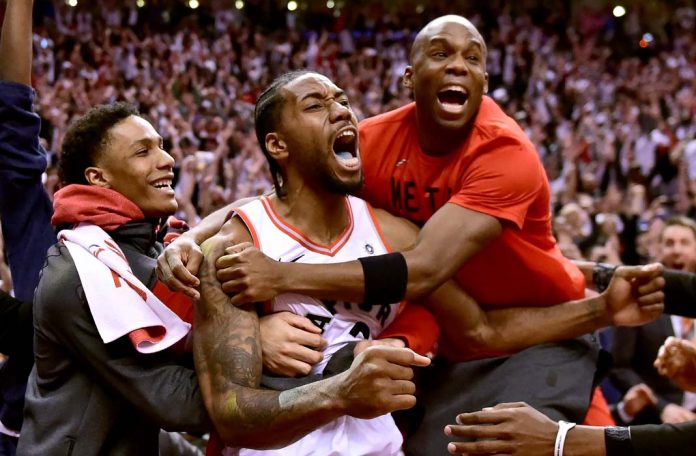With just 0.9 seconds on the clock left, Kawhi Leonard can’t help himself. In this extraordinary moment, we all witness something rare happen. The usually stoic Leonard is just roaring his head off in an instance of pure, unrestrained emotion. And we can’t blame him. In fact, compared to many other championship celebrations, it’s a bit tame.
Seconds later, Kyle Lowry tackles Leonard, cradling the game ball, as a grin splits his face wide open. Fred VanVleet walks off the court in a daze, struggling to comprehend the magnitude of what he just achieved. The Raptors’ bench floods the floor, in that joyful fashion every championship team does when they finally reach the top.
But, of course, it wasn’t always like this. Just one year ago, it looked like the window had closed for the Raptors. However, as we all know, success doesn’t come without failure first. The Toronto Raptors had their fair share of disappointment first.
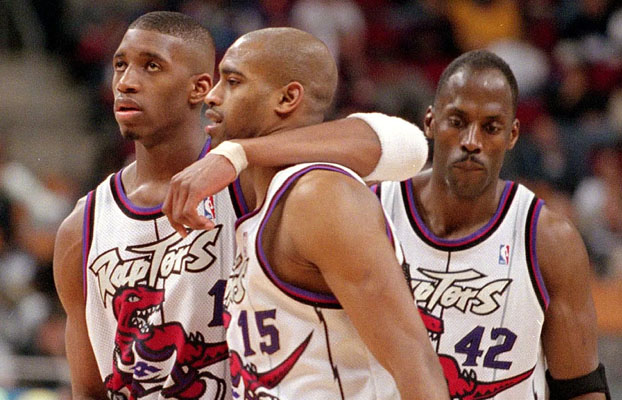
Once upon a time, the Toronto Raptors were the one team you couldn’t help but feel sorry for. As the only NBA team outside of the United States, the Raptors weren’t exactly anybody’s first pick to play for. Abandoned in Canada after the Vancouver Grizzlies were forced to relocate, the Raptors’ situation wasn’t much better. Basketball was America’s sport, and time after time, it just looked like nobody wanted to play in Toronto.
First, it was Damon Stoudamire, the diminutive PG who was Toronto’s first-ever draft pick, but then requested a trade. Then, it was Tracy McGrady and Vince Carter, the explosive pair cousins who first put Toronto on the basketball map. Both would leave, one after the other, McGrady for a bigger market and more opportunity while Carter because of a worsening relationship with the front office.
Vince Carter’s break up with the Raptors was particularly heartbreaking. Carter was their first real franchise player, a true superstar who dazzled crowds and gave basketball a purpose in Canada. He stayed when McGrady left and led Toronto to their first-ever playoffs victory. Carter wasn’t just any ordinary star, he represented an entire country’s basketball dreams. But, with all that he did for the franchise, it was all the more painful when he requested a trade. Carter felt misled by the front office, and after years of treading water with a mediocre supporting cast, he didn’t want to stick around any longer.
On the heels of Vince Carter came Chris Bosh, the new hope of the franchise. Bosh, however, was never even able to find the same middling success as Carter had with Toronto. Bosh averaged 20.2 points and 9.4 rebounds in seven seasons with the Raptors but never even got past the first round. In 2009 and 2010, the Raptors missed the playoffs in consecutive years, both career years statistically for Bosh. At this point, fans just braced themselves as Bosh entered free agency. Sure enough, he chose to leave, fleeing to sunny Miami to form a superstar trio with Dwyane Wade and LeBron James
For a few years, Toronto was just another bad basketball team. From 2010-13, the Raptors finished a collective 79-151. The lone bright spot was Andrea Bargnani, the former number one overall pick who was developing slowly but steadily. Even that, however, ended up a disappointment, with Bargnani never being able to consistently stay healthy. At the end of the 2012 season, the Raptors’ best player was a 22-year-old DeMar DeRozan who averaged 16.7 points on 42.2% shooting. But, at a time when the Raptors’ future looked the bleakest, their fortune finally turned.
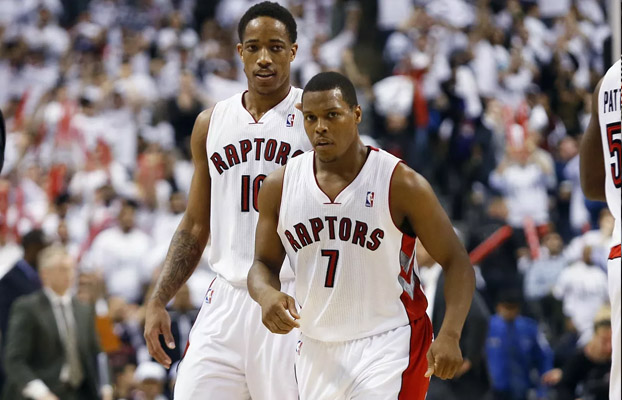
Kyle Lowry was there when the first signs of greatness started to build in Toronto. Lowry had already spent six years in the league and had never averaged over 14 PPG for a full season. Undersized and chubby, Lowry was supposed to cap out at as a starting level PG. As it turned out, however, Lowry was just a very, very late bloomer.
Just one year after arriving in Toronto, Lowry was putting up 17.9 points a night with 7.4 assists, on 42.3% from the field and 38.0% from 3PT. Those numbers are good, but most people chalked it up to just empty stats on a bad team. Only a year after that, however, in 2013-14, he did it again; this time, Toronto made the playoffs.
DeMar DeRozan also suddenly burst onto the scene that year, coinciding with Lowry’s sudden improvement. 2013-14 was DeRozan’s first All-Star appearance, and his first season averaging over 20 PPG.
The 2013-14 season was a remarkable season in two other ways as well. First, it was officially the start of the Raptors’ success. GM Masai Ujiri made several key trades, namely Rudy Gay to the Sacramento Kings and Andrea Bargnani to the New York Knicks. These moves freed up minutes for developing players like DeMar DeRozan and Terrence Ross, as well as brought back proven role players like Patrick Patterson and Greivis Vasquez.
The second aspect isn’t quite as happy. In a way, that year would be the start of Toronto’s infamous playoffs woes. Paul Pierce blocked Kyle Lowry’s potential game-winning lay-up in the dying seconds of Game 7 against the Brooklyn Nets, ending the young team’s first playoff run in the first round. Both DeRozan and Lowry struggled from the field during the series, but credit was still given for playing hard the whole time. Toronto finished the season 48-34, a franchise record.
Next season, however, was a step in the wrong direction. Both Lowry and DeRozan struggled with injuries, and the roster’s lack of depth was becoming all the more apparent. Sixth man Lou Williams was the sole bench player that could be depended on but wasn’t enough to staunch the bleeding. Toronto still managed to set another franchise-record with 49 wins, but their weaknesses were rapidly exposed in the playoffs.
The lack of offensive creators led to a stagnant isolation-heavy offense, which was picked up apart by the Washington Wizards in just four games. Once again, Paul Pierce was the hero of the series after switching teams to the Wizards the previous summer. Both Lowry and Williams shot below 32% from the field, and DeRozan managed just 40.0%. For the second year in a row, the Raptors’ star backcourt disappointed in the playoffs. Even worse, after three promising years with the team, both Terrence Ross and Jonas Valanciunas had plateaued in growth. Ujiri knew the team needed changes and acted accordingly that summer.
The 2015 offseason propelled Toronto into true powerhouse status in the East. The Raptors picked up versatile guard/forwards in Delon Wright and Norman Powell in the draft and added veteran PG Cory Joseph in free agency. Offseason signee DeMarre Carroll also provided some much-needed wing defense and shooting to cover for DeRozan’s weaknesses, while new center Bismack Biyombo rounded out the big man rotation. Ujiri chose to let Lou Williams walk, trusting that his new additions would be cheaper, better alternatives off the bench.
The result was 56 wins, a third straight year of setting franchise records and the deepest playoff run in franchise history. This time, it took the King himself to defeat the Raptors, as LeBron James and his Cleveland Cavaliers settled the series in six games during the Eastern Conference Finals.
Both DeRozan and Lowry were named All-Stars that year, as Lowry entered the ranks of the elite. Lowry averaged 21.2 PPG that season, along with 4.7 rebounds and 6.7 assists. He continued to launch up threes, shooting 38.8% on an eye-popping 7.8 attempts per game. The Raptors now had a cemented star duo in the backcourt and still had much more room for improvement.
At this point, however, there was the question of how the Raptors could take the next step. Despite having an excellent pair of players in Lowry and DeRozan, Toronto still lacked a true superstar. They needed a player who could put the team on his back, not just through the regular season but into the playoffs. A player who could match the gravity of LeBron James in a playoff series and be counted on.
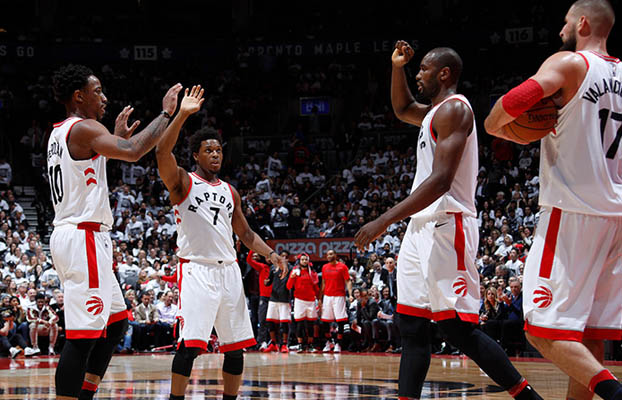
DeMar DeRozan gave it his best shot the next season. In 2016-17, DeRozan averaged 27.3 points, en route to his fourth straight All-Star appearance. Lowry also put up career-highs in efficiency and points, averaging 22.4 points per game on 46.4% from the field.
Once again, however, the season ended in disappointment. The Raptors won 51 games but lost in the playoffs in embarrassing fashion. By now, Toronto could no longer use their youth as an excuse for poor playoff performances. DeRozan was 27, Lowry 30. It was this core’s 4th go-around in the post-season, and the novelty of just being a playoffs team had worn off in Toronto. Fans wanted to win now, and win something big.
It took the Raptors six games to dispatch the sixth-seeded and inexperienced Milwaukee Bucks, foreshadowing the debacle that was yet to come. The Cavaliers demolished the Raptors in four, earning LeBron the nickname of “LeBronto,” signifying his dominance over the North.
The season, however, wasn’t a total loss. In the long run, it would return more positives than negatives. During the season, the Raptors swapped the inconsistent Terrence Ross for defensive ace Serge Ibaka. In the draft, they added PG Fred VanVleet, F Pascal Siakam, and C Jakob Poeltl. Neither VanVleet and Siakam played big minutes, but the experience on a competitive team was tremendous to their development. Although nobody would know it at the time, both Siakam and VanVleet would go on to be vital contributors to a championship team.
Heading into the 2017-18 season, there was now a sense of urgency. DeRozan and Lowry, in particular, were feeling the pressure after four straight years of underperforming in the playoffs. The two had become inseparable friends at this point, photo-bombing each other and always doing their interviews together. Both understood the stakes they were playing for the next season, however. If either one of them disappointed again, there was a high chance neither would be on the team next season. Lowry would end up re-signing with the Raptors that summer, but the shortened three-year deal told him enough.
Toronto then shocked everybody by winning 59 games, setting a fourth franchise record in five years. This time, it felt different. The Raptors had home-court advantage throughout the entire Eastern playoffs, claiming the first seed in the East. They looked hungry, playing with a vigor not seen in previous years. There were higher stakes than just basketball now; DeRozan and Lowry were playing for the very survival of their friendship.
It was a different system, and at assistant coach Nick Nurse’s urging, the Raptors had incorporated more ball-movement in their offense. DeRozan and Lowry both had down years statistically, but the rest of the team was much more involved. The Raptors were known for having the best bench in the league that season, headlined by VanVleet, Delon Wright, Norman Powell, C.J. Miles, and Siakam. Rookie forward O.G. Anunoby stepped into a starting role, earning his status as another one of the Raptors’ draft night gems. They looked better than ever, at the very peak of their franchise’s existence.
Without question, this was Lowry and DeRozan’s best shot. LeBron James and the Cavaliers were losing steam after star guard Kyrie Irving demanded a trade. Irving himself was out with a knee injury for the entire playoffs, leaving his new Celtics team star-less. The 76ers were definitely talented but unproven in their first playoffs appearance. While the Golden State Warriors still loomed large in the West, you couldn’t blame a Raptors’ fan for being excited. Once they got to the Finals, anything could happen.
Yet, when the gun went off, Toronto once again stumbled out the gates. It took six games to dispose of the Washington Wizards, as Toronto let an out-of-shape John Wall dominate early on. When the Cavaliers reared their heads once more in Round 2, this time as just the fourth seed, the Raptors were helpless.
The King reigned supreme in yet another battle, killing this iteration of the Raptors once and for all. Toronto dropped both games at home to start the series and was then put to sleep in Game 3 after James drilled a runner to win the game. In Game 4, the Cavaliers rocked the Raptors by 35 points. The jokes were relentless. The Raptors couldn’t beat LeBron, no matter what round, no matter what seed. Toronto was just a choking team.
It was over. GM Masai Ujiri knew it. He saw it in the Sixers’ developing dynamic duo of Embiid and Simmons. He saw the new talent rapidly accumulating in Boston. Soon-to-be league MVP Antetokounmpo was in Milwaukee getting better every year, and Ujiri knew the window was closing. This Raptors team wasn’t going to cut it. If he didn’t do something fast, it wouldn’t be long before the Raptors’ championship hopes went extinct.
And so, Ujiri made the type of move that a man gambles his entire career on. He had put too much of his soul into the Toronto Raptors to see them fail. The Raptors made the move that we all knew was objectively the logical thing to do, but that didn’t make it any less shocking.
First, he fired beloved head coach Dwane Casey, who was just named Coach of the Year that season. To Ujiri, Casey’s offense was too archaic, depending too much on DeMar DeRozan, who was far from dependable in the playoffs.
Assistant Nick Nurse would step in as the head coach, as someone who could hopefully bridge the Raptors towards a more modern playstyle. Firing Casey was only the precursor to the real decision, however. Ujiri was already thinking long and hard about shaking up the roster.
On June 15, 2018, it was made public that superstar forward Kawhi Leonard no longer wanted to be with the San Antonio Spurs. Leonard had one year remaining on his contract and would be an unrestricted free agent in the summer of 2019. His split from the organization evolved from growing mistrust between the two sides after Leonard suffered a quad injury before the season began. San Antonio’s medical staff cleared Leonard for play while Leonard insisted that he wasn’t ready.
Immediately, everybody’s thoughts jumped to the Los Angeles Lakers. It was, after all, Leonard’s home town, and no shortage of reports claimed that Leonard wanted to return to Los Angeles. But, the Lakers chose to bide their time, banking on being able to sign Leonard in 2019 without having to lose assets.
The Raptors weren’t the only team interested in Leonard, of course. The Philadelphia 76ers and Boston Celtics were also both in discussions with San Antonio, but neither team was willing to pay the price the Spurs wanted. In his last healthy season, Leonard had averaged 25.5 points and 5.8 rebounds, on 48.5% from the field and 38.0% from 3PT. Leonard was also a four-time All-Defensive team member, a Finals MVP, and an NBA champion. On top of it all, he was still only 26.
Ujiri pounced. He knew what type of player Kawhi Leonard was and bet the house on it. The Raptors had never been linked to Leonard in the past. Toronto had one year to convince Leonard this was the city he wanted to play in. Not only would the Raptors have to meet expectations, but they would have to exceed them. Kawhi Leonard wouldn’t come cheap, and the Raptors knew how much of a risk it would be.
The Spurs didn’t want to tank, preferring to receive established veterans instead of young prospects. Losing just wasn’t their style, and they wanted to continue their history of playoffs basketball. San Antonio wanted a star in return for Leonard to pair with LaMarcus Aldridge, so they could continue competing in the West. The Sixers weren’t about to do that, and neither was Boston. So, Ujiri offered the Spurs something that fit the bill: DeMar DeRozan.
DeRozan, still only 28, was in the midst of his prime. He improved every season of his career and had even added a bit of a 3PT shot. DeRozan was the one who led Toronto to the ECF and was the face of the franchise. None of their recent success could’ve come without him. At this point, DeMar DeRozan had come to symbolize the Raptors, for better or for worse.
Most importantly, DeMar DeRozan was the one star who chose to stay in Toronto. When he had a chance to leave in 2016, there was no shortage of suitors. It was no secret that his hometown Lakers wanted him, and it wouldn’t be the first time a star left Toronto for a more glamorous destination. So, when DeMar DeRozan decided he wanted his legacy to be in Toronto, not Los Angeles, he broke the precedence. When that happened, DeRozan forged a bond with the city that could never be broken.
Jeremy Lin’s quote the next day illuminated this particularly strong relationship. Despite his multiple failures, DeRozan was loved in Toronto like no other basketball player ever was.
In a way, DeRozan did end up being the catalyst that pushed Toronto over the top. Without him, Masai Ujiri wouldn’t have had a star player he could swap for Kawhi Leonard. In DeRozan’s own words, he was the “sacrificial lamb,” and ultimately, he played his role. It wasn’t the role he wanted, or the one Raptors fans thought he would have, but nonetheless, he can be directly linked to the championship.
Poeltl would accompany DeRozan to San Antonio along with a 2019 protected pick. The Raptors were also fortunate enough to snag Danny Green in the trade, the 6’6″ wing with elite 3-and-D skills. Together, Green would make up the backcourt with the now 31-year-old Kyle Lowry.
Raptors fans were delighted to have Leonard but were unsure about how to treat him. Leonard seemed cold, emotionless, and didn’t appear like the type of personality that represented the lively city of Toronto.
It didn’t take long for fans to start to warm up to their new franchise player, however. The Raptors started the 2018-19 season 10-1, with Leonard leading the charge. A new energy had engulfed the team, and even the most diehard DeRozan fan couldn’t help but admit they were a joy to watch.
Serge Ibaka, who had looked old and washed up just months ago, looked spry and engaged again. He was much more comfortable on offense, and as a result, started to regain his defensive form. Then, there was Pascal Siakam, whose relentless motor was finally paying off on the court, earning himself big minutes in big games. Danny Green’s arrival also provided the veteran 3-and-D presence Toronto hadn’t had since Demarre Carroll, but now with Green’s championship pedigree. Together, Leonard and Green breathed new life into the team, as their professionalism and work ethic spread contagiously.
Lowry, in particular, underwent another transformation. The Kyle Lowry we used to know was cheerful and playful, a child in a man’s body. The same happiness was still there sometimes in 2019, but more often than before, it was accompanied by a lean, hungry look in his eyes. Lowry knew he was aging, and it was time to cement his legacy.
His demeanor wasn’t the only thing that changed. Leonard and Green’s sharpshooting afforded Lowry spacing on the court like never before, and fans started seeing a much more free-flowing version of the PG. When the team traded for C Marc Gasol in February, it was made even better, as Lowry now had the opportunity to play with four guys at a time who could shoot and play defense. Gone were the days of Terrence Ross and DeMar DeRozan struggling to just keep track of their man off-ball. Instead, Lowry had four All-Defensive players covering his back, a security he never felt before.
The Marc Gasol deal was important in another way as well. Ever-alert, Masai Ujiri snatched him from the Memphis Grizzlies soon after he became available on the trade market. In return, Toronto gave up Jonas Valanciunas and Delon Wright.
Just like that, Kyle Lowry became the last Raptor standing from the original team that first made the playoffs in 2013-14 – the same man who, once upon a time, wasn’t even sure he’d be a starter on the team. Lowry’s story has come to resemble the Raptors’ own path, from unwanted and written off to the very elite and envied.
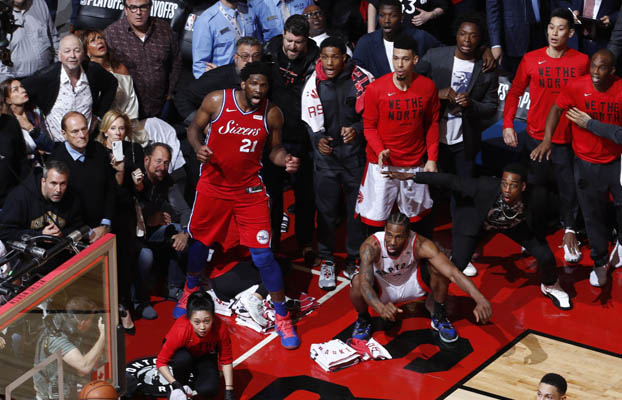
We know what happens next. Leonard averages 26.6 points, 7.3 rebounds, 3.3 assists, and 1.8 steals on 49.6 FG% and 37.1 3PT%. Siakam finishes his break out year with 16.9 PPG and 6.9 REB, slashing a ridiculous 54.9 FG% and 36.9 3PT%. The Raptors go on to complete the greatest season in franchise history, through one of the toughest playoffs paths a championship team has ever taken. Leonard is immortalized forever after making the first buzzer-beating game-winner in NBA history during Game 7 against the 76ers, and Toronto carries their momentum all the way into the Finals. There, they meet the Golden State Warriors, who, through an unfortunate sequence of events, lose two All-Stars to devastating injuries but still put up a valiant fight.
Kyle Lowry finally redeems himself that series, scoring 11 straight points to open up Game 6, finishing with 22 total. Leonard is crowned Finals MVP, after averaging 28.5 points and 9.8 rebounds.
The Raptors have climbed to the peak of basketball success, but it doesn’t look like they’re thinking about descending any time soon. Leonard is still just 27 years old, with a new burgeoning sidekick in the 24-year-old Siakam. The rest of the roster is admittedly aging, but after the work Ujiri has done already, it’s in good hands. At the end of the day, no matter what happens in the next five years, the Raptors have already made an indelible mark on the sports world.
Once written off as past their prime, the Raptors adapted and never stopped trying. They’re the team who saw the odds stacked against them and simply ignored the numbers because that’s not what defines success. And, as Kawhi Leonard once said, “I like being the underdog so they don’t expect what’s going to happen. It pushes me to work harder and do the things I’m not doing better.”
Follow me on
Instagram: @j_persources
Twitter: @j_persources

